Create and manage dataset parameters
A dataset parameter is a customizable field that you can add to a dataset worksheet and reference in formulas and in custom SQL. Creating dataset parameters and referencing them allows you to dynamically replace values used in calculations.
Use a parameter instead of a constant value for what-if and user input analysis. Using a parameter lets users change its value very quickly. For example, you might want to compare product sales growth by a variable 2%, 5%, and 10% percent. A parameter can quickly inject this variable value into a formula.
Dataset parameters can also improve performance for expensive workbook queries. Use dataset parameters to filter the data down to only what is needed.
If you want to use a parameter with a data model instead of a dataset, see Pass a value from a workbook control to a data model control.
User requirements
The ability to create, edit, delete, and use parameters in datasets requires the following:
- You must be assigned an account type with the Create, edit, and publish datasets permission enabled.
- You must be the the dataset owner or be granted Can edit dataset permissions.
The ability to view parameters in a dataset, requires the following:
- You must be assigned an account type with the View datasets permission enabled.
- You must be the the dataset owner or be granted Can view dataset permissions.
View dataset parameters in a dataset worksheet
From the Sigma Home page, select an existing dataset or create a new one. See Create Datasets.
When viewing a dataset, access dataset parameters when viewing the Worksheet tab for the dataset, in the left panel:
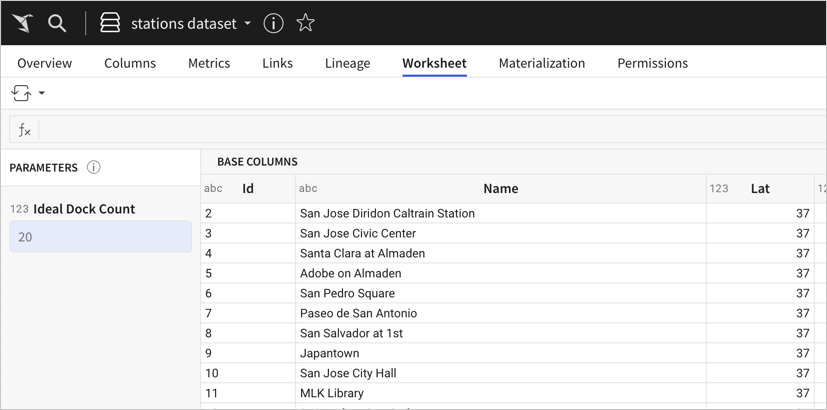
In the left panel, all existing dataset parameters are shown under Parameters. For each parameter, you can see:
- Data type: Represents the value type of the parameter, such as text (abc), number (123), or date (calendar). For more information see Supported data types and formats.
- Parameter name: The name of the parameter.
- Parameter value: The current value of the parameter. When editing the dataset, you can input a new parameter value. Depending on the parameter settings, you might choose a value from a list, input text, input a number, or select a date.
- Parameter menu: Menu to edit, duplicate, or delete the parameter. Select the
to open the menu. This menu is only available when editing the dataset.
Create a dataset parameter
-
Open a dataset, then open the Worksheet tab for the dataset.
-
Click Edit.
-
If the left control panel is not already open, expand it by clicking Show Controls in the toolbar, or by selecting the Controls bar.
-
In the Parameters section, click Add Parameter.
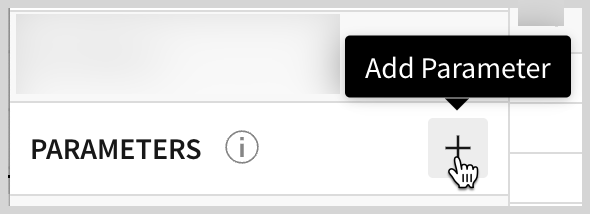
The Add Parameter modal opens.
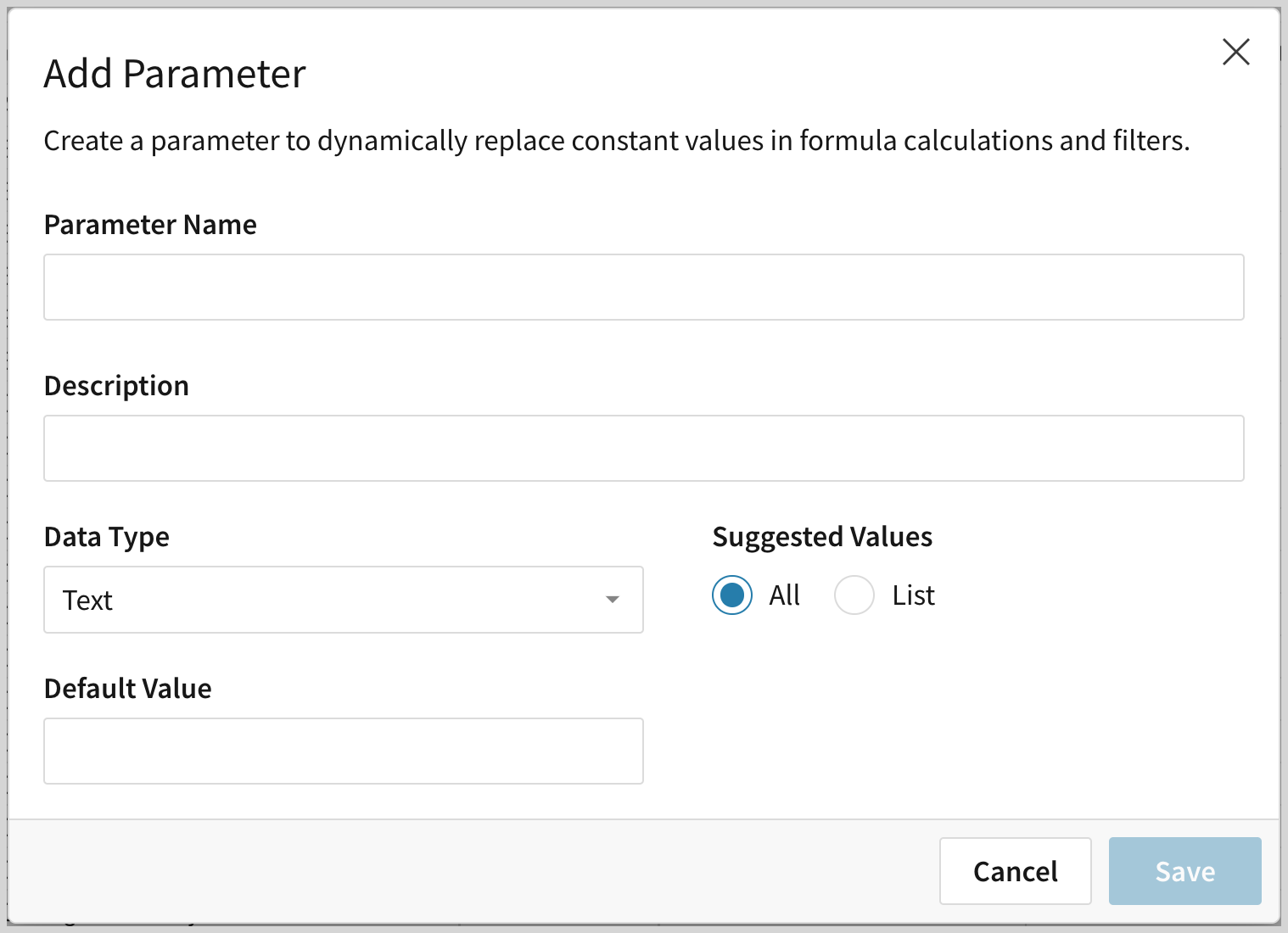
-
For Parameter Name, enter a name for the parameter.
-
(Optional) Add a description.
-
Select the Data Type (Text, Number, or Date) for the parameter.
-
The Suggested Values option determines the parameter’s input type. Select either:
- All: Depending on the data type, can be a text, number, or date value.
- List: A custom set of value options. Users can select any value in the list. See Use a list of values in a dataset parameter.
-
(Optional) Specify a Default Value for the parameter.
-
(Optional) For date or number data types, specify a Format for the parameter value.
-
Click Save.
After creating a parameter, you can use it in one of the following ways:
- In the dataset worksheet left Controls panel, change the value.
- Reference the parameter in a formula, such as in a new dataset column. See Reference a dataset parameter in a formula in a dataset worksheet.
- Update the value of the parameter based on the selection in a workbook control. See Parameters in Workbooks.
Use a list of values in a dataset parameter
-
Follow the steps to create a dataset parameter, then for Suggested Values, select List.
-
(Optional) For a date or number data type, specify a Format for the parameter value. For example, format a Number value as currency.
-
In the Values List, add each value. If you defined a display format, the Display Value reflects the formatting.
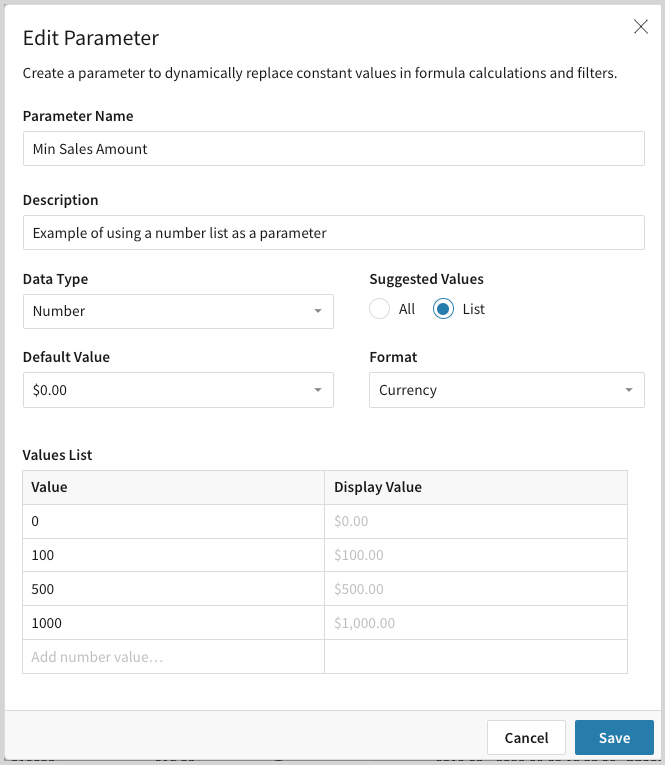
-
(Optional) In the Default Value dropdown menu, select one of the values from the list.
-
Click Save.
Reference a dataset parameter in a formula in a dataset worksheet
You can reference a dataset parameter by name in a worksheet column formula. The formula uses the value of the parameter and automatically updates when the parameter value is changed.
For example, for a dataset with a Revenue column, you might create a Min Sales Amount parameter, then calculate a formula to evaluate whether the sales revenue is greater than the minimum sales amount:
-
Add a new column to the dataset.
-
In the formula bar for the new column, enter the name of the dataset parameter surrounded by square brackets. For example,
[Min Sales Amount].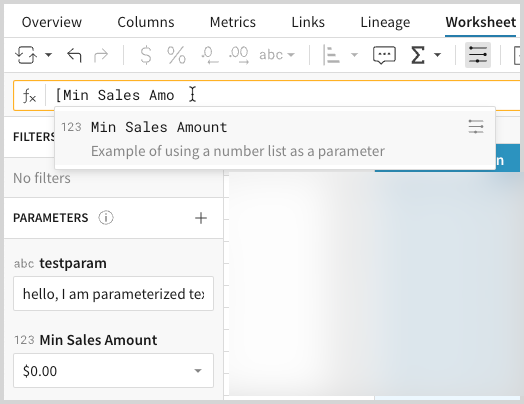
-
Rename the column to reflect the formula. For example, Min Sales Param.
-
In the parameter list, update the value of the parameter and observe the changes to the column.

-
Modify the column formula to use the parameter in a calculation. For example, evaluate whether the Revenue for each row in the column is greater than the Min Sales Amount parameter value using the formula:
[Revenue] > [Min Sales Amount]Sigma automatically calculates a Boolean (logical) value for the column.
-
In the parameter list, change the value of the parameter and observe the changes to the true/false values in the column.
The calculated column automatically updates when you enter a new parameter value.
Filter a dataset worksheet with a dataset parameter
To filter a dataset worksheet based on a dataset parameter:
-
Create a parameter. See Create a dataset parameter.
-
Reference the parameter in a column formula. See Reference a dataset parameter in a formula in a dataset worksheet.
-
Create a filter for that column:
-
From the column menu, select Add Filter.
-
In the Add Filter modal, select the filter type and the filter value(s) to filter in the dataset. For example, choose to display only True values.
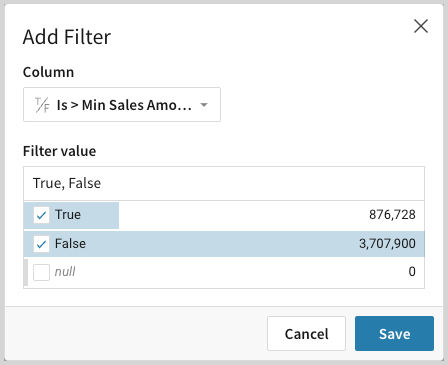
-
Click Save.
The filter appears in the side panel in the Filters section. You can update the parameter and the filter from the panel.
-
Reference a dataset parameter in SQL
You can create a dataset or populate a workbook element by writing a SQL query against a connected data platform. You can use dataset parameters in your SQL query by wrapping the name of the parameter in curly brackets:
{{<dataset-parameter-name>}}
After you update a SQL statement to reference a parameter, changes to the parameter value propagate to the SQL source and refresh the data.
To reference a dataset parameter in SQL:
-
In a workbook, create a data element from SQL. See Create a data element.
-
When writing the SQL, add the parameter by referencing its name in double curly brackets, replacing any spaces in the name with hyphens:
{{<parameter-name>}}For example:
select * from EXAMPLES.PLUGS_ELECTRONICS.F_POINT_OF_SALE where SALES_AMOUNT > {{min-sales-amount)} -
If the parameter value is passed into the SQL with single quotation marks, you can remove these quotation marks by prepending the special keyword "#raw" before the parameter name:
{{#raw <parameter name>}}
If you use the
#rawconfiguration value, row-level security can be bypassed, creating a security vulnerability. -
-
After saving the SQL, test the results by inputting a value in the parameter and review the output of the data element.
For more examples and details, see Write custom SQL and Create a dataset from SQL.
Delete a dataset parameter
To permanently delete a dataset parameter:
- Go to a dataset's worksheet tab.
- Click Edit.
- If the left control panel is not already open, expand it by clicking Show Controls in the toolbar, or by selecting the Controls bar.
- In the Parameters list, hover over the parameter that you want to delete, then click the caret to open the dropdown menu.
- Click Delete.
Updated 4 days ago
